Democracy is a funny old thing, an exercise in trust. We concentrate expertise and execution into the hands of the few, in the expectation that they will be steered by the will of the many. Hence town hall discussions, regular invitations for feedback, and public hearings on matters of note.
Hence also the deeply rooted distrust of the process and its occasionally wilful opacity, as captured by the late, great Douglas Adams:
"But Mr Dent, the plans have been available in the local planning office for the last nine months."
"Oh yes, well as soon as I heard I went straight round to see them, yesterday afternoon. You hadn't exactly gone out of your way to call attention to them, had you? I mean, like actually telling anybody or anything."
"But the plans were on display ..."
"On display? I eventually had to go down to the cellar to find them."
"That's the display department."
"With a flashlight."
"Ah, well the lights had probably gone."
"So had the stairs."
"But look, you found the notice didn't you?"
"Yes," said Arthur, "yes I did. It was on display in the bottom of a locked filing cabinet stuck in a disused lavatory with a sign on the door saying 'Beware of the Leopard'."
There’s no leopard in my story, but there is a nearby zoo, a spacious park, a golf course, an old museum, and a stand of spectacular native trees that are at least eighty years old. There is also a “very worthwhile and splendid” road-widening scheme, that when it is completed, will feature 19 – yes, nineteen – contiguous lanes of tarmac.
For some background to the saga of the St Lukes/Great North Road project, see Transportblog in February 2014 and June 2014, and Russell’s discussion here.
The bridge-widening and road-reshaping are largely a given (although I could grumble extensively about the inadequacy of provisions for people on bikes and on foot), but what’s currently at stake is a stand of six venerable pohutukawa trees, plus a poplar and a white pine. Here's some footage that gives a sense of how those trees fit the larger context: Patrick Reynolds and Stuff deployed a drone to give us a birds-eye view of where the birds will no longer be able to nest, at least if the tree-cutting part of the plan goes ahead.
Here are the trees from above, with the motorway to the left and Motat to the right.
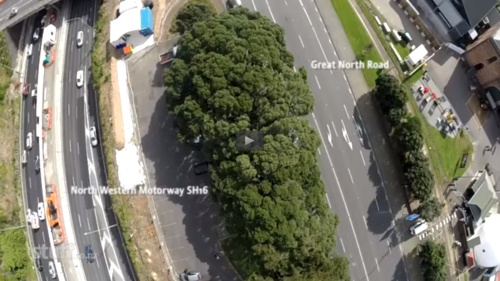
Here's another view, showing the bridge that will double in width.
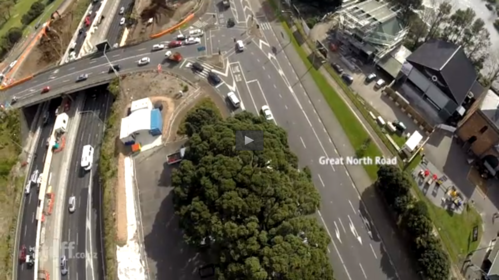
This shows you how the easterly stand of pohutukawa (nearest the viewer) connects with the roadside pohutukawa on the westerly side of the intersection, to form continuous a green street frontage that runs along Great North Road opposite Western Springs Park.
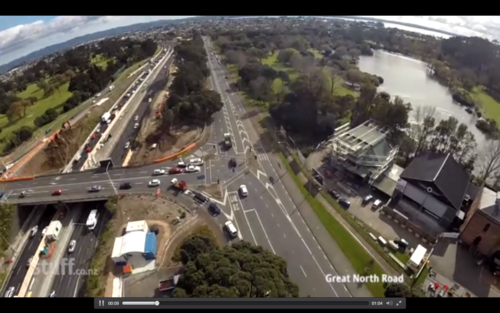
Looking back towards the east; with the trees (and the poplar and pine) on the right.
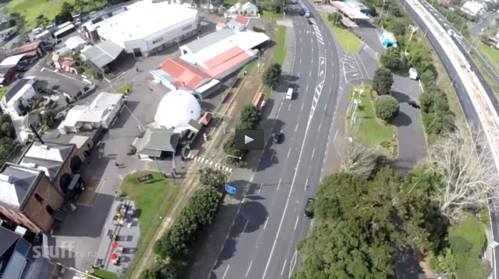
Here's how the pohutukawa look and feel at street level, looking west...
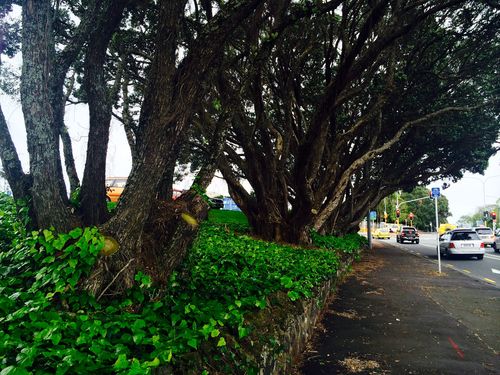
And looking east:

As Patrick puts it, they're "the only bit of civility in this area", in the midst of an increasingly traffic-choked environment.
They're also on the verge of flowering right now.
The news about the fate of the trees – for the sake of projected worst-case traffic flows in one direction during a two-hour afternoon weekday peak in 2026 – has been slow to get out. As has the fact that there's at least one workable alternative. I’d wager that most of the people who pass through that stretch of road every day have no idea whatsoever that these trees are potentially for the chop, to save them a few minutes a decade hence (assuming we're all still driving cars and not biking or bussing, or indeed swimming to work down the Great North Canal).
Still, there has been gathering opposition to the proposed destruction of this stand of 80-year-old pohutukawa, and an online petition currently has 1475 signatures.
Signing an online petition is one thing; making a formal submission is next level. Luckily for those who’ve never done it before, the Tree Council set up a page offering guidance, links, dates, and a template of talking points for those who aren’t good with words.
At the last minute, I made a submission, with my own heartfelt multi-page letter attached. I filed it online -- from my dining table, on a Friday afternoon, while children rattled around me asking about dinner. And in a fit of civic-mindedness, I ticked the box saying yes, I would like to speak to the hearing.
--
A few weeks ago, a giant wodge of paper arrived in the mail: this was the Hearing Agenda.
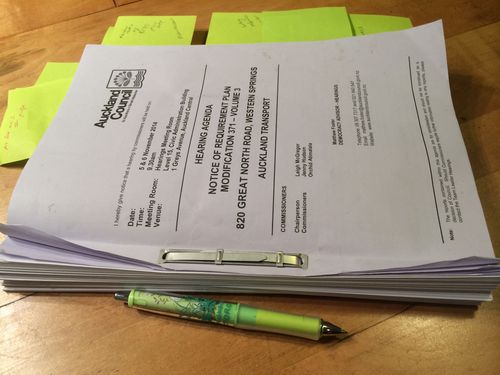
Flipping through it, I was heartened to see pages of submissions from ordinary people like me. Also, a few submissions on behalf of larger groups – the Western Bays Community Group; the Tree Council; Nikki Roberts and the many signatories to her online petition.
Notably, the Waitematā Local Board is there too: it has hired its own lawyers and consultants to oppose the tree removal (yes, that's one wing of the council taking the other to task). And there are strongly worded internal memos from two council departments -- Community, Policy, and Planning; and Parks, Sports and Recreation -- opposing removal of the trees and urging a reconsideration of the plan inside the larger picture of the “Western Springs recreation precinct”. Meanwhile, Motat submitted a slightly anaemic thumbs-up to the prospect of more parking, with a few cautions around foot safety where pedestrians encounter the tramlines.
I’d been given a speaking slot of 12.30 on Thursday. On Wednesday afternoon, I was making a few notes, trying not to get too nervous, when I got a message from the council’s Democracy Advisor, Matthew Foster – a perfectly nice chap, helpful at every step of the way – explaining that there was a problem with many of the submissions, including mine.
It has come to the commissioners attention from the hearing today that your submission has been lodged on the wrong process (there were two for this hearing - A resource consent and a notice of requirement) and the Commissioners will be unable to take it into account when making their decisions. This is addressed in the Council's report on the applications which was included in the agenda circulated before the hearing.
The Commissioners think it's fair to advise each of the submitters concerned in advance of their attendance so they can elect whether to attend or not given that they will have to travel into the city and pay for parking etc. They are happy to hear from you, however it is not legally possible to switch a submission from one of the processes to the other.
The commissioners will be happy to explain this more tomorrow if it doesn't quite make sense as this effects a number of submitters, they just feel it's fair to let you know before showing up.
--
This didn’t make sense to me, so I asked for more information. I was told that the mistake had been mentioned in the Hearing Agenda. Sure enough, there on page 921:
It is also noted that a number of submissions have been incorrectly lodged against resource consent application ref R/VCC/2013/4724/1 (which is the s127 variation to conditions of the regional consent for Stormwater Management – Quality, pursuant to Rule H.4.14.3.1 of the PAUP). All submissions should have been lodged referencing the Notice of Requirement for Alternation to Designation Plan Modification PA371. In any case, all submissions have been reviewed and reported on the project jointly.
In other words, a number of submissions had mistakenly used the reference number for a stormwater issue (specifically, how to handle the stormwater issues from the extra 762m2 of impervious area created if the trees are removed), instead of the reference number notifying intent to remove the trees. Moreover, “Resource Consent” was the wrong phrase, “Notice of Requirement” the correct one.
In other words, Beware of the Leopard.
Nonetheless, a speaking schedule had been made and citizens had been asked to show up -- until suddenly we weren’t. This didn’t seem quite right.
--
So I went back to the giant wodge of paper, and flipped through the 64 submissions just to see where, exactly, the legal impossibility inhered. I am not a lawyer. I am, however, a good reader, and I can count.
Of the 64 submissions:
- 6 had the correct reference number to PA371. (Supportive submissions from Motat and Vector; opposition from the Waitematā Local Board and three private citizens).
- 4 gave no case number, but described the location (820 Great North Road), mentioned the trees, and/but used the phrase “resource consent.”
- 54 submissions, including mine and the one from Nikki Roberts and her thousand-plus signatories, had the wrong case number, R/VCC/2013/4724/1 – but supplied an accurate description of the location (820 Great North Road) and the issue (removal of the big old pohutukawa).
- Of these 54, 22 had requested the right to speak at the hearing.
Presumably, I was among that 22. Presumably, also, the entire 54 submissions (and possibly the 4 that gave no case number) were “unable to be taken into account.” Again, including the thousand-plus signatories to the online petition.
So, of 64 submissions made, accepted, read, summarized, and recirculated, only six would actually count at the hearing.
--
Again, this doesn’t seem quite right. How had the wrong reference number become attached to so many of the submissions? My best forensic guess: most likely a small clerical error or transcription mistake had become amplified as a useful link or document was circulated with the wrong number in it.
Thus a bunch of people unfamiliar with the system, but determined (by crikey!) to be heard, acted in good faith and made their submissions accordingly – submissions they might never otherwise have made. The irony is that a tiny flaw in a democratic impulse designed to encourage participation has had wide ripples that may render that increased participation invalid.
But are the submissions invalid? Again, I’m not a lawyer, but can these voices be ruled out on a technicality when the intention of the submitters is otherwise clear? Even when they’ve unwittingly got the reference number wrong, they’ve gone to great pains to get the subject right:
“[Auckland Transport’s plan to] cut down 6 mature and invaluable pohutukawa trees.”
“Removal of 6 mature pohutukawa trees. ”
“Regarding removal of pohutukawas at St Luke’s Rd/ Great North Rd Interchange, Ref Resource Consent Application “R/VCC/2013/4724/1 820 Great North Road.”
“For the construction of an additional left turn lane from Great North Road onto St Lukes Road including the removal of six mature Pohutukawa trees (Metrosideros excels) from the site at 820 Great North Road.”
Notably, one submitter who entered the wrong reference number has added after it, in a nervous parenthesis “(as far as I can judge)”.
In another partly handwritten submission by a local resident who wishes to speak at the hearing, the wrong reference number is carefully transcribed in his handwriting, and a typed list of objections is appended. “These trees have been there for 80-90 years and will still be there in another 200-to-300 years from now,” he writes. “In that time span the motor car will be extinct.”
Another handwritten submission also uses the wrong reference number, except that in this case, the number alone has been carefully typed -- presumably by someone other than the citizen. (Someone at Auckland Council? Who knows?). Nevertheless, she makes her case crystal clear: she opposes “removal of pohutukawas to widen road.”

--
My question is this: why has the Council, in the face of what’s evidently a good-faith transcription error magnified several times over, decided to prioritise its own arcane numbering system over good plain English words? Which is more legible to the people trying to make their voices heard?
--
Submissions are a funny beast. You wonder whether anyone actually reads them; I like to think so, but they come with a built-in sense of futility. The forms are daunting, even the user-friendly ones. You fill in the boxes with names, dates, descriptions, and then at the last hurdle, you’re given a brief moment of expertise and eloquence sufficient to win hearts and change minds. The shift in registers can be a challenge to even the most engaged citizen.
Most of the submissions from people like me were made via the online form. Reading through them, you can see the uncertainty about how to speak, the right words to use, how to phrase things so as to be heard and taken seriously.
After the space for your name, the next question is “I am a:” The answers are eloquent:
[Person who] lives within walking distance of the 6 Pohutukawa trees. Interested party in the full notification. Concerned citizen at the lack of tree protection. Community member. Property owner and concerned ratepayer. Concerned Aucklander. Concerned citizen. New Zealander.
As someone who is all of those things, I’m flummoxed by many aspects of this encounter with Council and its ways.
That the pohutukawa along the boulevard were not (as I’d imagined, and I’m sure I wasn’t alone) protected on account of their age and native status.
That the grandness and cohesion these huge trees lend to the space -- to a broad road that can’t decide whether it’s a throughway, or a friendly gateway – wasn’t taken as a given in the design process, a creative constraint around which to shape a transport solution.
That the Hearing Agenda proudly and ironically bears the supercity logo for Auckland Council: a stylised pohutukawa flower.
That this same council, just eight years ago, fined a property developer a total of $100,000 (plus costs) for destroying a protected century-old pohutukawa in Royal Oak that was cherished by the community. As part of the restorative process, he was not only made to replace the tree, but obliged to sit and listen as his neighbours described what the tree had meant to them.
I do trust Auckland Council and Auckland Transport can find a way around the supposed “legal impossibility” of listening to their neighbours on what these trees mean to us. Let's hope this leopard is prepared to be flexible in the matter of its spots.